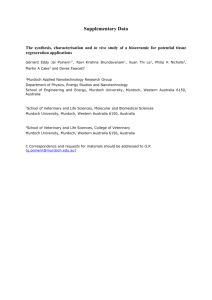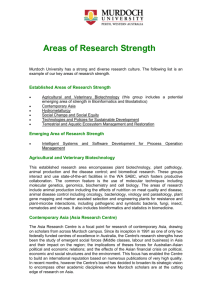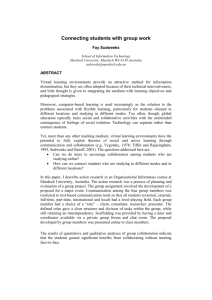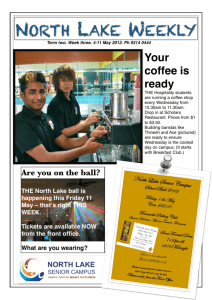Politics Challenges Facing Democracy
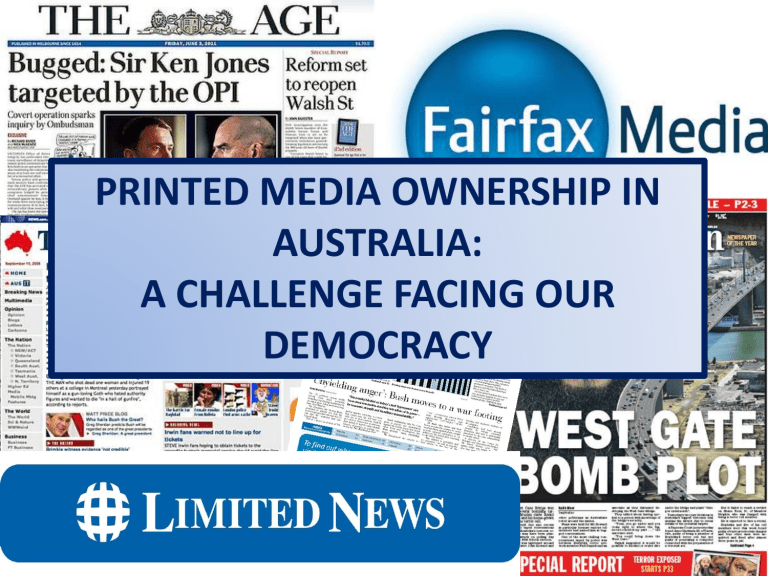
PRINTED MEDIA OWNERSHIP IN
AUSTRALIA:
A CHALLENGE FACING OUR
DEMOCRACY
Why is Printed Media Important?
•
Mechanism for Government accountability
•
Platform for politicians to win political and legislative support
•
Provides citizens with sufficient knowledge to form opinions and perceptions of society and the world as a whole
PROBLEMS!!
Media Ownership in Australia is limiting the diversity of reporting and opinion
Individuals are using their ownership over diverse media corporations to spread their personal interest and influence a large groups of Australians
Owners can build public support for specific issues
In the 19 th century, the goal of media owners changed from reporting to making a profit
The subjective nature of the media is being compromised. Our news sources report opinions as opposed to fact.
SO HOW DEMOCRATIC IS OUR MEDIA???
1. Media Ownership in Australia
The Hawke Era
• During the Hawke Government, there were restrictions limiting owners to one area of media. An individual or corporation could dominate either print, television or radio.
• Meanwhile, foreign investors could own only 15% of shares in an Australian media company and a total of 20%.
Post Hawke
• In the past few decades, the increase in globalisation and digital convergence has put a strain of this past arrangement
• Media users can no longer be classified as readers, listeners or viewers. Due to the internet, citizens can access a variety of media sources, forcing companies to adopt a network of media outlets to deliver a range of services to facilitate a wider audience.
• Corporations now also have to compete against other international organisations
Media Ownership cont
The New Law
• In October 2006, the Federal Parliament passed the Amendments to the
Broadcasting Services Act of 1992
• The main points:
• It removes restrictions on cross-media ownership by allowing individuals to invest in more than one area of media
• Maintains a diversity of local services by establishing a minimum requirement of local news to be broadcasted.
• Ensures that Australian media stays under Australian control. Though the regulations will be relaxed, the Government still maintains veto power over accepting foreign investment proposals.
• The Australian Press Council is a self-regulatory body which monitors the print media.
Print Media in Australia
• Though there is legislation protecting media, print media specifically is highly concentrated and is thus vulnerable
• Since individuals dominate this area of the media, it poses a dire threat to our democracy
2. Who Owns YOUR Media?
• The 2 main corporations that own national print Media are
Rupert Murdoch’s News Limited and John Fairfax Holdings.
• Together with other smaller businesses, they distribute news and sell it to other outlets such as the ABC.
70 %
30 %
According to Minister
Conroy, Murdoch’s
News Limited currently owns 70% of newspapers in
Australia.
Therefore, if there are individuals with such great control over our media, shouldn’t we know who they are and what affects they have on our news, politics and politicians??
Case Study: Rupert Murdoch
Murdoch’s News Limited includes over 130 newspapers an various other film and TV broadcasting corporations. Murdoch has become the symbol, for many, of the dangers of having media concentrated in the hands of few individuals. He has been accused of using his media resources in certain countries to support political parties which he can do business with and to undermine and attack parties whose policies are unfavourable to him. He is described by Crispin Hull in the Canberra Times as a man who uses the media to freely, “push a definite agenda.” He also allegedly uses print to hype his own films and attack media rivals.
Several years ago, when Murdoch tried to expand his Empire to China and please the Chinese leaders, he was criticised as putting his own financial interests before media freedom. This was demonstrated when Murdoch threw the BBC off the Star service as soon as he acquired it after it televised news coverage critical of the treatment of human rights protests in China. He also refused to allow HarperCollins from publishing Chris Patten’s memoirs, the last governor of Hong Kong, since they painted an unflattering picture of Chinese leaders.
Recently, Murdoch’s News of the World British tabloid was found guilty of hacking approximately 5,795 phones of celebrities, the Royal Family and specific citizens such as victims of the London Bombings and families of soldiers who had died in Iraq and Afghanistan.
Rupert Murdoch cont
Murdoch demonstrates how concentrated media ownership (which is facilitated by Australian legislation) can pose a threat to democracy:
• As he owns many large and popular corporations, Murdoch is able to spread his ideas and agenda to a diverse audience.
• Murdoch is able to control what is printed in the media. Though as an individual he has the right to express certain views, how can we rely on his newspapers reporting objectively on the pros and cons of any issue. This danger was illustrated when Murdoch openly supported the US-led war on Iraq because he said that it would lead to lower oil prices and thus better business. This means that because Murdoch can ultimately choose what his audience reads, he can influence their opinions and view of the world.
• Murdoch’s powerful and large corporation is hard to regulate, as was demonstrated by the phone hacking scandal in Britain.
• As a political figure, he challenges the notion of a free media being critical of the Government and holding it accountable.
Ultimately, Murdoch’s control and power challenges tolerance of diverse views, political dissent, free speech and a free, independent and critical media
Case Study: Gina Rinehart
Gina Rinehart is a Western Australian mining magnate with a net worth of 20 billion dollars.
Earlier this year, she became the largest shareholder of the Fairfax Media Group by increasing her stake to 12.8%. This, coupled with her 10% share of Ten Network gives her a platform to influence government policies and win public support. This is specifically relevant as this year, the Gillard Government aims to implement the Mining Tax, which Rinehart, as mining magnate opposes.
Despite Ten Network chairman Brian Long arguing that Rinehart has not, “sought to influence programming or editorial,” it is feared that she will use her position to influence and hamper
Government policy, specifically since she has been a vocal opponent of the Carbon Tax.
SO HOW DO THESE
INFLUENTIAL OWNERS OF
THE MEDIA THREATEN OUR
DEMOCRACY?
World Audit ranks Australia as 19 th in the World for Press Freedom. If we understand World Audit’s methodology, we can understand why Australia is suffering in this field. World Audit looks at 3 key areas:
1. Legal Environment- the laws and regulations that limit the media’s ability to operate and the positive impacts of constitution guarantees such as freedom of expression
Perhaps Australia’s legislative flaw is that its constitution does not safeguard its people from the powers exercised by media owners with concentrated powers. Instead of trying to regulate the media, the Parliament should perhaps limit the maximum control an individual can exercise in the media arena.
2. Political Environment- The degree of political control that is exercised over state owned and privately owned media.
The Commonwealth Parliament does not have direct control over Australian media. This is illustrated by the ABC. Though the ABC is Government sponsored, it freely criticises the
Government. Moreover, many politicians have criticised Judge Ray Finkelstein’s recommendation (in his report about the media) that supports implementing a Parliamentary watchdog to regulate
Australian media sources. Additionally, the print media and its owners can make the life of a
Government particularly hard by attacking their legislation and policies. This was illustrated in 2010 by The Australian Financial Review’s Laura Tingle and the ABC’s Fran Kelly criticising The Australian newspaper of being too tough on Gillard’s election campaign and her minority Government.
3. Economic Environment- the structure of media ownership, its transparency, concentration and corruption and bribery.
This area is perhaps Australia’s greatest flaw. As newspapers and media groups are generally privately owned, there is a great concentration of power in few hands. This, as has been previously mentioned, allows individuals to influence public opinion, pressure Government policy and decide what is being printed and read by Australians. This notion of control is highlighted by editorials on the eve of election in Australia wherein newspapers argue who which party should win and why.
3. Australia v Norway
According to World Audit, Norway is the 2 nd best democracy with regards to press freedom and media.
Where Norway and Australia differ is that Norway’s media concentration is regulated by the Media Ownership Act of 1997. The purpose of the Act is to encourage freedom of expression and a diverse and comprehensive range of media. Yet, the Government can intervene if an individual or a corporation gains a significant ownership position in the national, regional and local media market. A person who owns 1/3 of national media is considered to have a significant ownership position
4. Solution
Even though Australia is ranked as the 9
th
best democracy in the world, our poor ranking of 19
th
for press freedom demonstrates that media ownership is strongly harming our democracy. Therefore something must be done!
How to Fix Media Ownership
Using Norway as inspiration, Australia could legislate against concentrated media ownership by introducing a cap on how much an individual or corporation can own of any media source. This cap should cover print, television, internet and radio media. Government should not regulate media content (as Ray Finkelstein’s report suggests) but should monitor
WHO owns our media and HOW they are manipulating it.
HOW THIS WILL SOLVE PROBLEMS CAUSED BY CONCENTRATED PRINT MEDIA
Powerful individuals will not be able to utilise the media to:
1. Push a personal political, economic or social agenda
2. Criticise or support a specific political party and its policies and thus influence the public to do likewise
3. Build public support for certain political and social issues
Maintaining diverse ownership will encourage a diversity of opinions and views published in the media.
Citizens will no longer be influenced by the views of a powerful and rich individual.
As it will not be controlled by one individual, the commercial emphasis will decrease.
